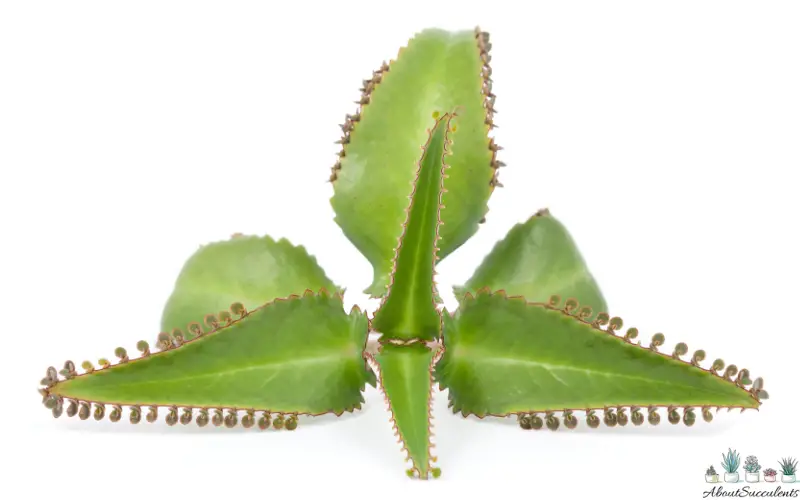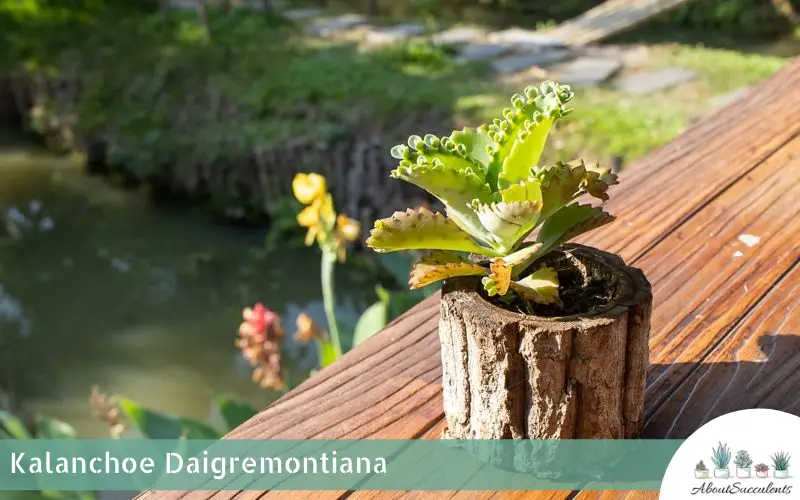
Kalanchoe daigremontiana is referred to as a monocarpic succulent which is a type of succulent that produces flowers only once then dies.
If the idea of a succulent dying after its flowers bloom is off-putting, let it be known that Kalanchoe daigremontiana is a succulent plant that is very easy to grow.
Kalanchoe daigremontiana is known by other names: Mother of Thousands, Alligator Plant, and Mexican Hat. It is a slender, glabrous plant that has erect cylindrical-shaped shoots with leaves with scar-like marks.
The leaves have a triangle shape, bluish-green color, and spots that appear brownish-black. Its stems look bare; the leaves give the plant an appearance of a miniature palm tree.
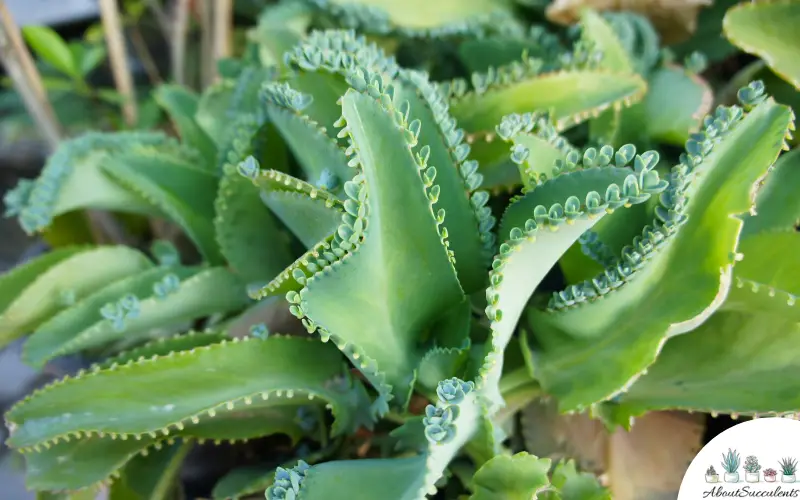
Mother of Thousands can grow up to 3-feet tall (90cm) tall and prefers a temperature that is not lower than 30° F (-1.1° C).
The succulent originates from the Crassulaceae family and is native to the Fiherenana River Valley and Androhibolava mountains in Southwestern Madagascar.
General Information:
Also known as: Mother of Thousands, Alligator Plant, and Mexican Hat.
Plant Family: Crassulaceae
Origin: Fiherenana River Valley and Androhibolava mountains in Southwestern Madagascar.
Height: 3-feet tall (90cm) tall
Exposure: Direct morning sun up to 6 hours (outdoors), indirect sun up to 6 hours (indoors)
Water Needs: Frequent watering schedule during the summer months; very little to no watering in the winter or cold season.
Soil Type: 2 parts soil with a soil substitute that has been cleared of weeds and pre-sterilized to eliminate bacteria and other contaminants, then add 2 parts peat moss.
Soil pH: Strongly Acidic (6.1 to 6.5 pH)
Tolerance: Drought; cannot tolerate frost
How To Grow Kalanchoe Daigremontiana
Kalanchoe daigremontiana is an attractive succulent to have in your home. Although the flowers may not appear when kept indoors, you should not worry too much about the succulent dying after it blooms.
The reason for this is that the tips of Mother of Thousands contain baby plantlets. If the mother plant dies after the flowers bloom, the tiny plantlets may drop and propagate.
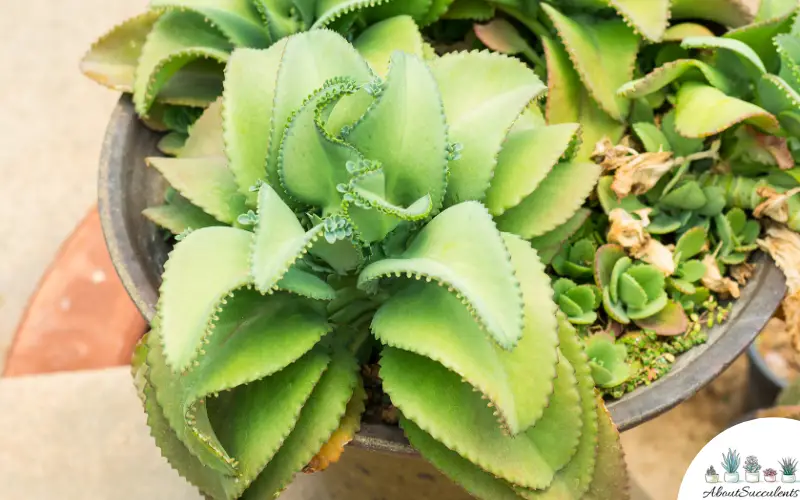
Now you know why Kalanchoe daigremontiana is called “Mother of Thousands”. If you are interested in having this beautiful succulent in your home, here are tips on how to grow it.
1. Sunlight
Kalanchoe daigremontiana is a fast-growing succulent plant. The plantlets propagate rapidly when they hit the ground. Some growers consider Mother of Thousands an invasive species.
It is advisable to grow Kalanchoe daigremontiana outdoors and to place it in an area in the garden where it can receive direct morning sun for 3 to 6 hours. Avoid planting Mother of Thousands in an area which gets direct afternoon sun.
If you live in a region of the world where temperatures can fall below 20° F (-6.7° C), then it would be best to grow the plant in a container and place it near a window that can give it indirect sunlight.
2. Watering
Kalanchoe daigremontiana is very resistant to drought and can survive long periods without water.
For proper care, the succulent should receive watering whenever the soil is dry to the touch.
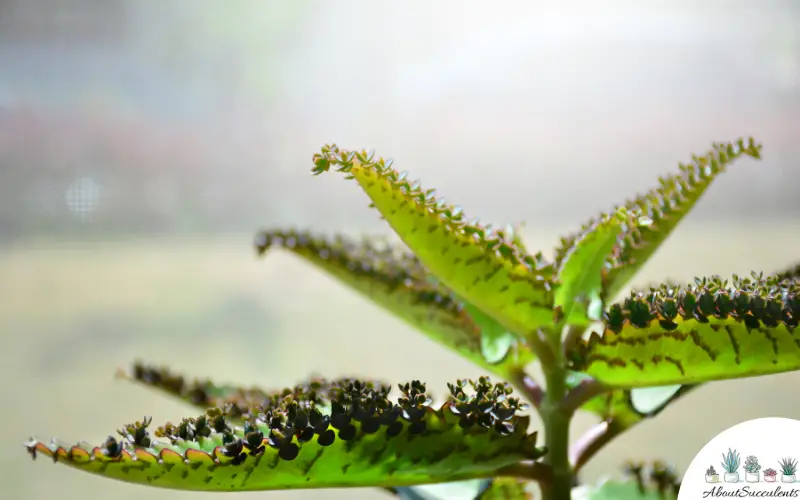
During the cold or winter season, greatly reduce the frequency of watering as the soil tends to remain moist for a longer period when temperatures are lower.
Overwatering can lead to root rot which can spread rapidly throughout the plant and cause its demise.
3. Pot and Soil
Plant Kalanchoe daigremontiana is a terracotta pot that has excellent drainage. The succulent cannot sit on water for an extended period or the roots will start to rot.
Fill up the terracotta pot with well-draining soil that will enable proper air circulation around the roots.
You can also make your own potting soil. Combine 2 parts soil with a soil substitute that has been cleared of weeds and pre-sterilized to eliminate bacteria and other contaminants. Add 2 parts peat moss to improve the soil’s moisture retention property.
How To Propagate Kalanchoe Daigremontiana
This is probably the easiest succulent to propagate. Mother of Thousands grows so fast that some succulent hobbyists have to resort to methods that keep it from overrunning the garden.
To propagate Kalanchoe daigremontiana, all you have to do is remove a plantlet gently from the mother plant’s leaf. Place the plantlet in a shaded area and allow it to develop calluses. From there, place the plantlet in well-draining soil.
Kalanchoe daigremontiana can also be propagated through the process of germination.
Step 1 – Gently remove the plantlets from the leaves of the mother plant.
Step 2 – Place the plantlets on top of well-draining soil.
Step 3 – Cover the pot with plastic.
Step 4 – Once the plantlets develop roots, move them to a new terracotta pot with well-draining soil
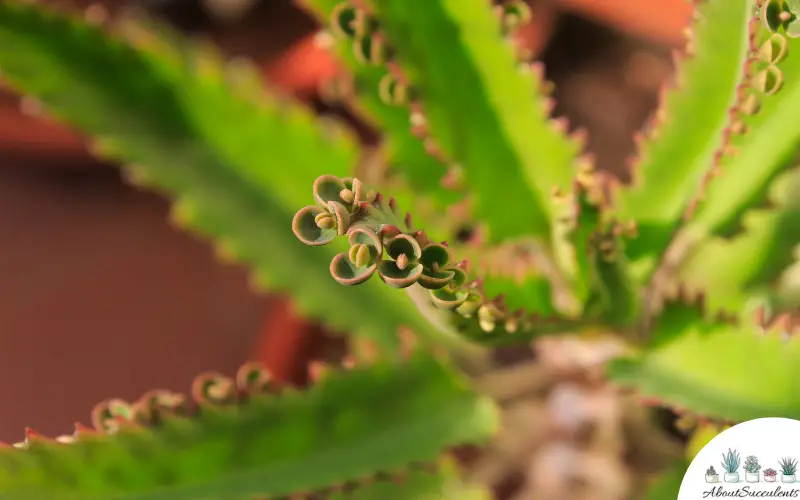
Frequently Asked Questions
Is Kalanchoe Daigremontiana Toxic for Cats and Dogs?
Yes, unfortunately, Kalanchoe daigremontiana has been identified as a succulent plant that is toxic for cats and dogs in the website of the American Society for the Prevention of Cruelty to Animals (ASPCA)
Symptoms to look out for include depression, gastrointestinal distress, and excessive salivation. These symptoms may manifest themselves only after a few hours of ingesting the plant.
Once you see any of these symptoms, bring your pet right away to the veterinarian.
Why is my Kalanchoe Daigremontiana Succulent Dying?
Kalanchoe daigremontiana is one of the most durable succulents you can ever grow.
It can grow under most conditions and will survive drought. There are 3 reasons why your Kalanchoe daigremontiana succulent is dying.
Overwatering
It is better to under-water than to overwater Mother of Thousands. As mentioned, the succulent can thrive even without water for months.
If the plant sits on water for a prolonged period, its roots will start to rot. When you see signs of deterioration, remove the infected areas right away.
Freezing Temperatures
Kalanchoe daigremonte is not tolerant of freezing temperatures. If your area experiences cold, freezing weather, it would be best to grow Mother of Thousands indoors.
Sun Overexposure
Overexposure to the sun can scorch Kalanchoe daigremontiana. If you are planning to move the succulent from indoors to outdoors, conduct the transition slowly.
First, place the succulent in an area in the garden that receives indirect heat from the morning sun. When the plant has acclimated to its surroundings, give it limited direct exposure to the morning sun.
Does Kalanchoe Daigremontiana Produce Flowers?
Yes, Kalanchoe daigremontiana produces large, pendulous, and bell-shaped flowers in the early winter. The flowers can grow up to 1.2-inches long or 3 cm.
Last Updated on June 10, 2022 by Sofia Lara
